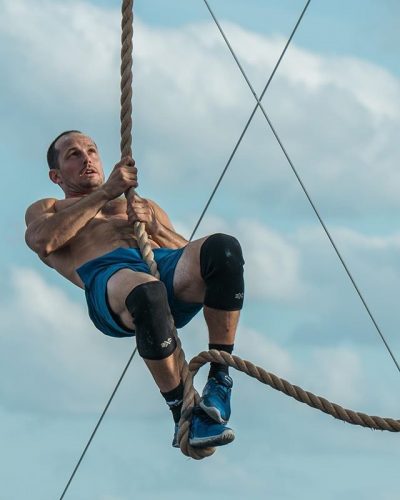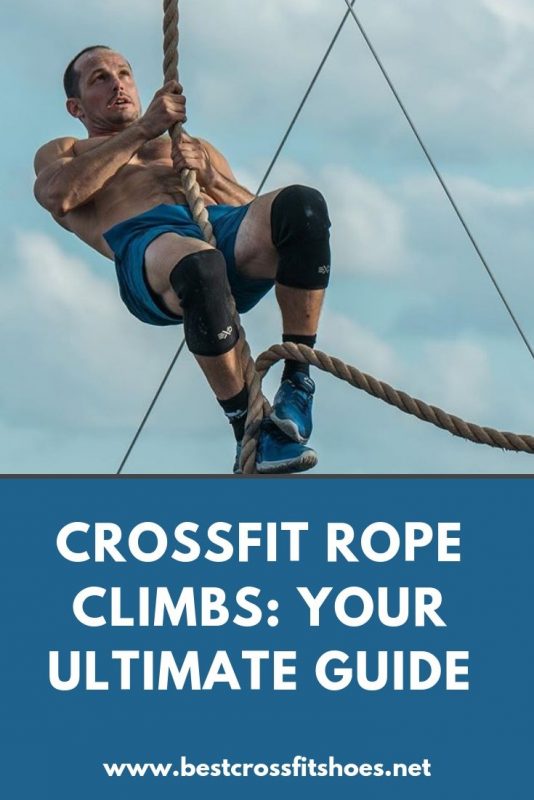In CrossFit, few exercises evoke a sense of challenge, excitement, and accomplishment quite like rope climbs. Scaling a vertical rope using nothing but your own strength and determination is a testament to both physical prowess and mental resilience. Whether you’re a CrossFit enthusiast or just beginning your fitness journey, mastering the art of rope climbs can unlock a world of benefits, both physical and mental.
Rope climbs are not only a functional movement that builds upper body and core strength but also serve as a powerful metaphor for overcoming obstacles in life. The journey toward conquering the rope is a transformative one that teaches us about discipline, perseverance, and the reward of pushing beyond our comfort zones. Keep on reading for tips, tricks, and the gear that you need to climb ropes like a boss!

Rope Climbing Tips for CrossFit
What’s the Deal with CrossFit Rope Climbs?
Rope climbs are to CrossFit like peanut butter is to bread. You can find them regularly in workouts, and also as a part of almost all competitions such as the CrossFit Games.
The truth is that they do require a moderate amount of upper body strength and the ability to grip something quite strongly for a long period of time. However, with the use of proper technique, you can reduce this effort considerably and get some much better results. Here are three of the most common foot locks that you might want to try out. See which one feels best to you.
3 Foot Locks to Use When Doing Rope Climbs
Try out these foot lock techniques for climbing ropes. Which one is best? That’s up to you!
However, it’s important to feel secure when you’re dangling 20 feet up in the air. It’s for this reason that we recommend starting with the S wrap, the most secure option. Once you’ve mastered that, move onto the J wrap, which is less secure but quicker.
When doing any of these options, remember to use your legs too. Stand up on the rope, instead of only pulling yourself up with your arms.
#1: S Wrap
This is one of the most secure foot locks because there’s lots of contact between the rope and the body. While secure, it’s probably the slowest option, both going up as well as down. This is because you have to shake the rope loose and then rewrap it with each ascent or descent. The friction can also cause abrasions on the legs so you may want to consider a shin guard.
Here’s how to do it:
- Warp you leg around the rope a full 360 degrees. The rope will be like a corkscrew around the lower leg and draped over the shoelaces of the base leg.
- Put your free foot on top of the base foot and clamp the rope between your feet.
Rope Climb: S-Wrap Technique
#2: The Fast J Wrap
The fast version of the J wrap uses the least amount of friction between the rope and the body. Instead, it relies on rope leverage to guide the rope down the outside of the legs so that it can be pinched between both feet. It’s very quick but can be a serious test of grip strength (find out how to improve grip strength here).
Here’s how you do it:
- Create a J shape and a kind of stirrup that the foot rests on
- The other foot provides a side clamp to keep the rope in place
- When descending, open the feet and allow the rope to freely slide between the shoes. However, be cautious as this can result in a free-fall if done too much.
Rope Climb: J-Wrap Technique
#3: Secure J Wrap
This option is a mix of both, secure but also pretty quick. It combines leverage and friction to make this happen.
Here’s how you do it:
- Wrap your base leg 3/4 of the way around the rope so that the rope feeds down between the legs and wraps behind the calf of the base let. It should stop on the outside of the foot.
- Feed the rope between the base foot and the other foot. Then, pinch the feet together which will clamp the rope in place.
- To descend, keep the heels together and turn the toes away from each other to reduce tension.
How to Get Better at Rope Climbing: Quick Tips
Whether you’re just starting out and are struggling to climb a rope at all, or if you want to improve your performance and do this exercise more quickly, you’ll want to check out these tips for climbing a rope.
#1: Grip Strength is Key
There’s no two ways about it, grip strength is vital if you want to do well on rope climbing. If you find your hands getting very fatigued during this exercise, try out some grip strength exercises to improve this. One common exercise is the towel pull-up. Throw a towel around a bar and pull yourself up with it. You may also want to try farmer’s carries with kettlebells (see our top picks here: Adjustable Kettlebell Sets).
#2: Upper Body Strength is Also Key
While legs and technique are certainly important, rope climbing is essentially a test of upper body strength. If you’re weak in this area, you may have a hard time climbing a rope, or improving your performance. Hit the weights and get stronger!
#3: Technique is Key
As with most things, there is a correct, and incorrect technique. Done incorrectly, only the strongest people with the most grip strength can climb ropes. However, with great technique, most people can do it. Pay attention to form and ask your trainer for help with this.
Some hooks are faster but less secure and vice versa. Start with the more secure ones, and then progress to the quicker ones once you master that.
#4: Don’t Forget the Legs
It’s easy to get stuck on using only your arms to pull yourself up. However, you should be using your feet to lock the rope in, and then stand up on it. This will allow you to get higher without having to pull with your arms, seriously reducing your fatigue.
Remind yourself to do this by looking down at your feet regularly, instead of just up at your hands.
#5: Ditch the Running Shoes
Probably the quickest way to tear up the mesh on a pair of running shoes is to climb a rope. Ditch them and get yourself a pair of CrossFit shoes that have protection on the sides especially for this.
#6: Safety First!
When you’re that high up in the air, pay attention to what you’re doing, especially on the descent. A free fall from 20 feet up can result in serious injuries. Use your feet to slow yourself down.
When you’re just starting out, use a 10-foot rope, or climb only halfway up a 20-foot one.
#7: Mental Resilience
Rope climbs require mental fortitude. CrossFit Games competitors train to overcome the fear of heights and embrace the challenge. They cultivate mental resilience, focusing on maintaining composure and staying calm under pressure, enabling them to execute rope climbs at an accelerated pace.
#8: Dedicated Training
CrossFit Games athletes train specifically for rope climbs, incorporating them into their regular workouts. They practice rope climbs at varying heights and intensities, working on speed, efficiency, and endurance. Specific drills and intervals help them refine their technique and develop the necessary strength and stamina.
Rope Climb Drills
Check out these rope climb variations and exercises to improve your performance:
What are Some Climbing Ropes that you Recommend?
If you have a high enough ceiling at home, or at your business, then you may want to consider getting your own rope. Here are some of the top gym climbing ropes that we recommend:
Can I do Rope Climbs in any Kind of Shoe?
Of course, you can climb a rope in any kind of athletic shoes that you want. Your results will likely be quite similar no matter if you’re wearing running shoes, cross-trainers, or CrossFit shoes.
However, where the major difference comes in is how well your shoes can stand up to this test. Regular rope climbing can tear up the inside of your shoes like nothing else, especially the mesh uppers of most running shoes.
It’s for this reason that we recommend sticking with CrossFit shoes that have rope guard protection. This basically means an extra layer of material on in the inside of them, or more durable materials in that specific area. This material can also be a bit sticker than mesh for example, so you may find it slightly easier to grip the rope as well.
Check out some of our top recommendations for the best CrossFit shoes:
Do I Need Shin Guards for CrossFit Rope Climbs?
Some people who regularly use ropes as a training tool invest in shin guards. Other CrossFitters wear knee-high socks and find that they offer enough protection.
Finally, there are other people who use neither of these things and find that the rope doesn’t really irritate them. We recommend trying this option of nothing, or with knee-high socks first.
Then, if you find your shins getting torn up, invest in some CrossFit shin guards. Whether or not you need them really depends on how tough your skin is, as well as your climbing technique. You may also consider using them for deadlifts, box jumps (see our top picks for a plyometric box here), and other kinds of fitness training.
FAQs
There are a number of common questions that people have about this topic. Here are the answers to some of the most popular ones.
What muscles do rope climbs work?
Rope climbs primarily target the upper body muscles, including the arms, shoulders, back, and grip. They also engage the core and leg muscles for stabilization and leg wrap technique.
What are the benefits of rope climbs in CrossFit?
Rope climbs in CrossFit help improve upper body and grip strength, build muscular endurance, enhance coordination and body control, and challenge mental resilience.
Are there different techniques for rope climbs?
Yes, there are various techniques for rope climbs, including the J-hook technique, S-wrap technique, or legless climbs, where athletes rely solely on upper body strength.
How can I improve my rope climbing skills?
To improve rope climbing skills, you can practice grip and forearm strength exercises, upper body pulling movements like pull-ups and rows, and incorporate specific rope climbing drills into your training routine.
What safety precautions should I take when doing rope climbs?
When performing rope climbs, it is essential to use proper technique, wear suitable footwear, and have a soft landing surface below the rope. Athletes should also ensure the rope is securely anchored and inspected for any signs of wear or damage.
Can beginners do rope climbs?
Yes, beginners can work on progressing towards rope climbs by starting with modified versions, such as partial climbs, seated climbs, or using assistance like foot wraps or a spotter.
Are there any alternatives to rope climbs?
Yes, there are alternative exercises that can provide similar benefits to rope climbs, such as towel pull-ups, rope pulls, or using a climbing rope attachment on a cable machine.
Can I incorporate rope climbs into my regular fitness routine, even if I don’t do CrossFit?
Rope climbs can be incorporated into any fitness routine to add variety and challenge. They are a great way to work on upper body and grip strength while improving overall athleticism.
Are there competitions or events in CrossFit that involve rope climbs?
Yes, rope climbs are often featured in CrossFit competitions and events, including the CrossFit Games. Athletes may be challenged to complete a specific number of rope climbs within a given time or as part of a larger workout.
Have your Say about CrossFit Rope Climbs
Do you have any tips, tricks or recommendations for someone who wants to get started with, or improve their rope climbs during a WOD or CrossFit competition? Leave a comment below and let us know what you think.
Also be sure to give this article a share on Facebook, Pinterest, or Twitter. It’ll help other CrossFit enthusiasts, like yourself find this useful resource.

CrossFit Rope Climbing Tips
Last update on 2023-08-20 / Affiliate links / Images from Amazon Product Advertising API

